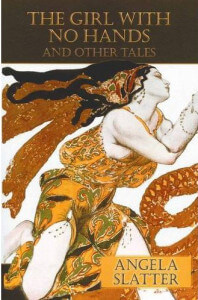 Title: “The Girl with No Hands & Other Tales”
Title: “The Girl with No Hands & Other Tales”
Author: Angela Slatter
Genre: Fantasy / Fairy Tale / Lore
Pages: 210
Type: Collection
Stories: 16
—
What’s Friday Story Dissection?
It’s a weekly feature on the blog where I cast a more in-depth look into short stories, either in a collection or in an anthology. The idea is for these short stories to exist within the context of a loose narrative, determined by a theme, intent and story order intended by author or editor.
Anthologies have adopted detailed prompts to narrow down the wiggle space of submissions, thus creating a more focused narrative. I believe short story collections tell a larger story with individual stories feeding off and layering a top each other.
It’s my intent to break down stories to their elements – a detailed, spoiler-full review with the mandatory quotes as a base to speak about the short story collection/anthology at length. This is a practice Bulgarian literature teachers would implement, loosely translated as “analytical literary essay”, but on a much smaller scale. Plus, I intend to weave in personal digressions, so there’s that, too.
—
“Bluebeard” by Angela Slatter (1/16)
As a small boy, I remember owning a moderately thick book with illustrated fairy tales, but an edge to the fan favourites. It had The Little Mermaid (depressing foam-end included), Little Red Riding Hood (with triple the murder and wolf surgery) and a handful of others. I recall a haunting image where Ariel’s sisters come to her rescue, sheared heads abob the waves, one holding a dagger.
Murder the prince or die. A simple decision – choose between your love for someone or your love for yourself.
Dark material for a child to read, but then again I always had an affinity towards darkness and characters who committed unspeakable deeds. That’s why Bluebeard got stuck in my head as a character. The first time I stumbled on his story, I developed an instant crush.
Whoever illustrated the book knew how to draw handsome bearded men. What intrigued me more was his modus operandi; the ritualistic murders he committed over and over again with several simple steps.
Bluebeard employs psychological terror and scare tactics to end with a brutal execution where the wife becomes a collectable trophy. Domination and fetishizing remain at the core of his actions, seeking to destroy his wives, strip them from their power, end them at their weakest and display them as a reminder he is Creator in his own castle.
In my book, the scene with the big reveal held nothing back. Blood painted the spacious floor in red from wall to wall, while each wife hung from the walls, shriveled and grey in her best gown. A museum of insolence and disobedience, which are crimes against his persona.
That’s what the story says. Girls, listen to your husbands or your life will be at your husband’s mercy and none would be the wiser. What I saw was dormant heroines. I’ve retold myself the story over and over where the wives assume different roles upon their discovery.
They WAKE, ravenous as undead revenants.
They WALK, luminous in the beauty of their enchanted dresses, seeking justice.
They RISE, celestial as angels who wish to smite their executioner.
They SPEAK, intangible as eternal voices to guide the newest wife out of danger.
Just a few childhood outcomes I wish had happened, instead of the predictable “and the wife and her sister were saved by their brothers”.
Angela Slatter’s “Bluebeard” arrives as a natural extinction of these fantasies and delivers an updated, ornate narrative, which plays to my sensibilities. Slatter balances out the references to a certain era with the mention of bankers and cars, American immigrants and Paris as the setting, but the brushstrokes are fine and the story retains fairy tales’ most essential quality – a sense of timelessness.

“Bluebeard” by Herman Vogel
The narrator is 10-year-old, Lily, daughter of a Parisian courtesan, who acts as an onlooker as her mother falls into tie dangerous couple dynamic with Davide, banker and devoted patron. Since this is a fairy tale, Lily possesses incredible intellect beyond her years, peppers each and every observation with cynicism and feels jaded in her interaction with her world, while still keeping a spark of innocence and vulnerability.
By introducing a daughter, Slatter studies womanhood and motherhood in a world, which has belonged to men for centuries, but is not always ruled by them. The evolution of the mother-daughter relationship as Lily and her mother fight for survival and find salvation gives Slatter the space to interpret the most common roles women are typecast as: the mother, the daughter, the whore, the crone and the saint, though the last two roles are reserved for Davide’s mother.
The central theme explored through Lily’s interactions with her mother and her navigation in the situation created by Divide’s invitation to spend time in his house outside the city is power and the female awakening to power. “Bluebeard” introduces Lily’s matter as a fragile beauty, who prefers “pink matter” to “grey matter”:
“Her breath smells like champagne, but bitter as you might expect.
Something inside her turns it sweet, I’m not sure what. She’s a sugar-candy kind of girl, bright and crystalline as she reclines on the sofa – a chaise lounge, more correctly. Her hair is spun like golden sugar, her eyebrows so light they may as well not be there, her lashes so contrastingly black that they must be dyed, her skin pale pink, and her mouth a rosebud pout, filled with small pearly teeth.”
In one paragraph, Lily’s mother is established as the embodiment of femininity and beauty as every detail accentuates the otherworldly beauty that has allowed this woman to enchant men into complete adoration of her.
Yes, she’s a courtesan and sells her body for men. She’s a plaything that obeys her patrons but has used her skills and beauty as tools to secure comfortable living for herself. She has shown resilience, backbone and cunning. Slatter has already planted the potential within to transcend her role as a prostitute and assume control over body and fate.
The transformation involves pain as Davide leads her to a private room, where his mother, an old crone driven to violent insanity, tortures her for her sins. Long before this reveal, Lily has sensed an impending danger and doubts her mother.
“My mother loves me, this I know, but I do not know if she loves me best.”
However, once Davide’s mother attacks Lily in the story’s finale, the transformation reaches its final stage. The raw instinct to protect her child, her agency and her act of defiance change how Lily and subsequently the reader views the character.
“My mother stands behind her and she is the most beautiful thing I have ever seen.”
This is the first instance, Lily uses the word beautiful to describe her mother. In the first passage above, her appearance has been broken down to the tiniest detail to portray an ideal many still consider attractive, yet this is the moment where Lily sees her mother as truly beautiful. As this beauty does not lie in her hips, lips and fingertips, but in her spirit and its power.

“Bluebeard” by Edmund Dulac
In a sense, this makes for the perfect opener for this collection as “Bluebeard” signify female awakening to power. David isn’t Bluebeard, because he seeks out to prey on women and exert his control and dominance. Instead, his mother acts as the true predator, possessed by her own warped piety. Here is what Slatter says of Davide:
“…he is a big man, a bear who’s been shaved and taught to walk upright. His smile is strange and his eyes are yellow. He smells like ambergris.”
Although likening men to beasts – bears or wolves – traditionally serves as a technique to warn about the character’s savagery and inherent danger, Slatter’s passive structure in the first sentence does the opposite in the sense it suggests the animal has been domesticated, its spirit broken. Every word after this is meant to subtract from his authority. Even though Davide is beastly, he’s seen as less.
Instead the animalistic cruelty and viciousness are transferred to his mother, who at one point is compared to a “hunting dog”.
Fairy tales bind us together.
They are an ubiquitous inheritance passed down from parent to child, serve as an iconography of childhood and relay truths about our world.
Retellings allows to make sense of the tradition, connect to those before us, reevaluate how society works and demand changes within this tradition. Compared to the world that brought the original version of this story, our current social make-up necessitates reinterpretations as to include more roles for female characters – the intellectual, the savior, the bread winner, and the adversary, who has believable motives behind her actions.
Angela Slatter approaches these tales with respect and her retellings carry the mesmerizing enchantment I discovered within the originals. “Bluebeard” remains a memorable tale, one of my personal favourites.
—
Chances are not many have come to this point. If you have and this has been something you enjoyed, please donate to my PayPal account. I’ve been reviewing books for more than five years now and this project takes a lot of time and effort. Any appreciation would be grand! If you can’t donate, like and share the post! Comment even.


[…] Plus, I intend to weave in personal digressions, so there’s that, too. — Stories Dissected: [1] “Bluebeard” […]
[…] Plus, I intend to weave in personal digressions, so there’s that, too. — Stories Dissected: [1] “Bluebeard” [2] “The Living Book” […]
[…] Plus, I intend to weave in personal digressions, so there’s that, too. — Stories Dissected: [1] “Bluebeard” [2] “The Living Book” [3] “The Jacaranda Wife” […]
[…] Plus, I intend to weave in personal digressions, so there’s that, too. — Stories Dissected: [1] “Bluebeard” [2] “The Living Book” [3] “The Jacaranda Wife” [4] “Red Skein” […]
[…] Plus, I intend to weave in personal digressions, so there’s that, too. — Stories Dissected: [1] “Bluebeard” [2] “The Living Book” [3] “The Jacaranda Wife” [4] “Red Skein” [5] “The Chrysanthemum […]
[…] Plus, I intend to weave in personal digressions, so there’s that, too. — Stories Dissected: [1] “Bluebeard” [2] “The Living Book” [3] “The Jacaranda Wife” [4] “Red Skein” [5] “The Chrysanthemum […]